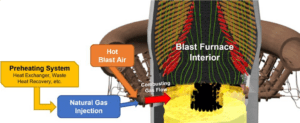CIVS, SMSVC, and National Lab Collaborative Project Presentations at DOE HPC4EI Manufacturing Day

Two CIVS, SMSVC, and National Lab collaborative projects funded by the HPC4Mfg program will be presented at the DOE Advanced Manufacturing Day on October 2nd. The HPC4Mfg projects utilize High-Performance Computing (HPC) powered simulation modeling to optimize steelmaking processes. The CIVS team have been collaborated with expert scientists at Lawrence Livermore National Laboratory (LLNL) , Argonne National Laboratory (ANL). ArcelorMittal and the Streel Manufacturing Simulation and Visualization (SMSVC) project committees.
The first project worked to use and expand existing computational fluid dynamics (CFD) codes developed by CIVS in conjunction with HPC resources at LLNL to simulate conditions within the blast furnace for improved fuel injection efficiency. In particular, the applied portion of this work focused on simulation of a range of natural gas injection rates at an industry blast furnace. Preheated natural gas injection was also included as a component of the work to study the potential benefits to blast furnace operation. The second project focused on high-fidelity HPC-powered CFD simulation of a walking beam steel slab reheating furnace with ANL researchers. This ongoing work is focused on studying the impacts of a wide range of operating parameters for fuel and oxygen enrichment at the furnace burners on heat transfer, thermal uniformity in the slabs, and other parameters key to product quality and total process energy efficiency.
In 2015, the Office of Energy Efficiency and Renewable Energy’s (EERE) Advanced Manufacturing Office (AMO) initiated the High Performance Computing for Manufacturing (HPC4Mfg) program to pair industry partners with the DOE national laboratories to solve production and design problems, with the goal of reducing national energy consumption. HPC4Mfg has since been expanded to HPC4EI, which is funded by AMO, EERE’s Hydrogen and Fuel Cell Technologies Office (HFTO) and Vehicle Technologies Office (VTO), and by the Office of Fossil Energy (FE).

